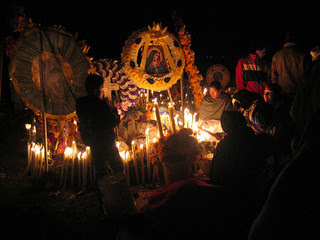Nursery rhymes as a learning tools
 |
| Se hace de noche Photo credit: Alex Pearson licensed CC BY-SA 2.0 |
This article is dedicated to one such rhyme that has been traditionally sung by and to kids all over the Spanish-speaking universe and enjoyed overwhelmingly. The song is called, Se hace de noche (night is falling or night falls).
Se hace de noche
Se hace de noche is a nursery rhyme in widespread use in every Spanish-speaking country in some form or the other. This cute little poem talks about some spooky things such as vampires, knives, castles, etc. and is often taken as a Halloween song by the Spanish-speakers even though the association wasn’t originally intended. The song opens with the description of nightfall and gets more and more spookier with the thickening plot and the growing suspense as it develops, finally culminating in a silly ending that makes the kids burst out in laughter. The kids just love it for the way an air of suspense builds up only to diffuse in a totally harmless and jovial finale.
This is a zero-calorie story that entertains and teaches without placing any overhead on one’s mind whatsoever. If you can become a kid, you can reinforce the spooky vocabulary with actions, gameplays, funny voices...the possibilities are only limited by your creativity! The rhyme itself is extremely short, one key trait of all nursery rhymes, and helps you painlessly absorb a key grammar concept, the reflexive pronouns. The vocabulary is basic and themed the grammar, light; it has every ingredient to stick to your memory for life with no mental stunts on your part.
The Luis Pescetti version
The most common version is the one by Luis Pescetti who has wonderfully performed it with an echo so you can easily practice along as you can see in the video below.
Here is the rhyme with an English translation for the Spanish learners in you:
Se hace de noche (Night falls),
Se ve un castillo (You see a castle),
Se abre la puerta (A door opens),
Sale un vampiro (A vampire emerges),
¡Toma un cuchillo (He takes a knife)!
yyyyy... (Anddddd...)
Unta pan con mantequilla (Spreads the bread with butter),
Unta pan con mantequilla,
Unta pan con mantequilla.
The harmless witch
There is another version that talks about a witch instead of a vampire and is equally fun to sing although there’s no rhyme scheme in this one. This one has an even simpler vocabulary and is good for those who want to add a little Mexican touch to their Spanish. It goes:
 |
| La bruja Photo credit: Lee Haywood licensed CC BY-SA 2.0 |
Sale la bruja (Emerges the witch),
Volando en su escoba (Flying on her broomstick),
Llega a su casa (She arrives at her house),
Entra a la cocina (She enters the kitchen),
¡Saca un cuchillo (She draws a knife)!
yyyyy...
Y le unta mantequilla a su bolillo (And spreads butter on her bread),
Y le unta mantequilla a su bolillo,
Y le unta mantequilla a su bolillo.
All the culture in a piece of bread
One culturally interesting thing to note in the second rhyme above is the word, bolillo. It is actually a very Mexican word and you must know what it is if you aspire to become an authority on Mexican culture. It’s a type of savory bread often made of sourdough originating in Mexico and traditionally baked in an horno de piedra (stone oven).
They are known by various local names throughout Mexico, such as bolillos and pan blanco in the north, pan francés in the northeast, barras in the Yucatán, torcido and birote in Sinaloa, and birotes also in Sonora and Guadalajara.
The version from Chile
Coming back to the rhyme, Chile has its own variation that is equally enjoyable if your heart is closer to Chile than Mexico. This one goes:
Son las doce de la noche (It’s twelve o’clock in the night),
La hora más horripilante (The gruesome hour),
Sale un monsturo (Emerges a monster),
¡Peludo con un cuchillo filudo (Hairy with a sharp knife)!
yyyyy...
Le echa mantequilla al pan (He puts butter on bread),
Le echa mantequilla al pan,
Le echa mantequilla al pan.
No matter which version you choose, we bet you will have a tough time trying to get rid of the Spanish you absorb from them. Give it a shot!
















0 comments:
Post a Comment